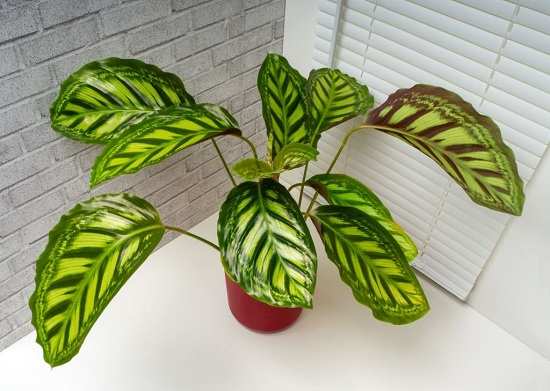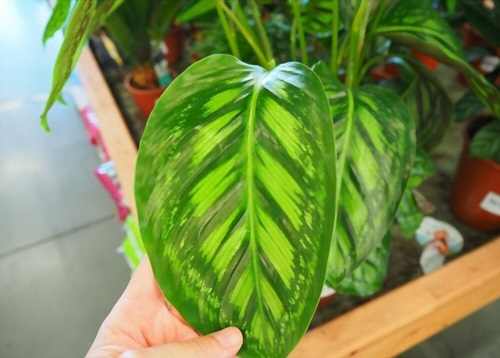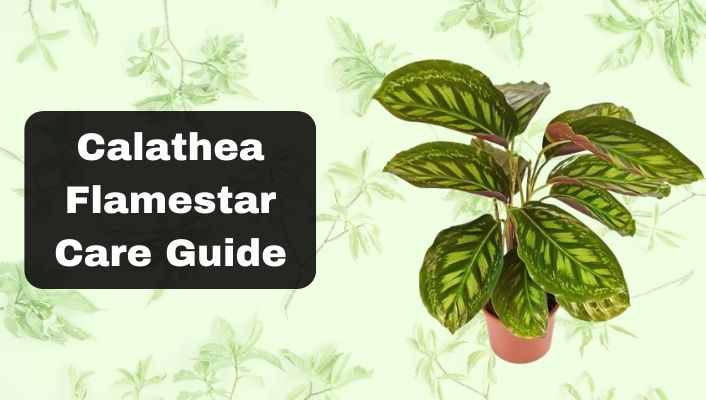Calathea Flamestar is a stunning Brazilian tropical plant that brightens up many homes and offices indoors, as it has many properties of a houseplant. It is a must-have, and any tropical collection is incomplete without it.
The beauty of this plant can brighten up any room of your house as it provides a vibrant decorative look. It has thick and rich foliage that combines patterns with a bushy look. Calathea Flamestar surely is an eye-catcher and a conversation starter.
Calathea Flamestar is not too hard to care for and maintain. But it would need attention if you want a plant that is in perfectly healthy condition and shows off its full potential.
Calathea Flamestar is a plant whose knowledge is crucial for the right care. In the following article, we have discussed every essential point about the caring routine for Calathea Flamestar. We guarantee you that following the tips will lead to a nice and charming plant.
Post Contents
- Calathea Flamestar Key Information:
- Calathea Flamestar Care and Maintenance:
- Buying and Placement of the Calathea Flamestar:
- Light Requirements:
- Watering and Misting Leaves:
- Humidity Requirements:
- Cleaning and Pruning:
- Fertilizer Feeding:
- Calathea Flamestar Repotting:
- The Correct Soil Mixture:
- Propagating the Calathea Flamestar:
- Toxicity Information:
- Frequently Asked Questions:
- Conclusion:
- Author
Calathea Flamestar Key Information:
Discover key information about Calathea Flamestar, including its name, family, origin, and care guidelines.
| Information | Description |
|---|---|
| Common Name | Calathea Flamestar |
| Scientific Name | Calathea ‘Flamestar’ |
| Family | Marantaceae |
| Native to | Hybrid |
| Growth Habit | Herbaceous perennial |
| Leaf Pattern | Oval-shaped with dark red markings |
| Leaf Color | Dark green with red undersides |
| Light | Medium to bright indirect light |
| Watering | Keep soil consistently moist |
| Humidity | Requires high humidity levels |
| Temperature | Prefers warm temperatures (18-26°C) |
Calathea Flamestar Care and Maintenance:
The first point to add to the topic of interest is that this plant needs attention. You have to ensure frequent watering, indirect sunlight and good air conditions.

The plant will show you the symptoms if something is incorrect in the regular requirements. For perfect care and maintenance, you might feel the need to adopt a routine.
Read More: Calathea Rufibarba Care (Propagation & Growing Tips)
Buying and Placement of the Calathea Flamestar:
If you spot a Calathea Flamestar and buy it, the first important issue is placing it in a suitable spot in terms of its requirements. But remember that it is not mixed up with other plants; keep it alone as it is tropical and has different needs.
Moreover, other plants become a risk of spreading pests and diseases. You can keep it with other plants after a week or two of bringing them home.
Carefully inspect your new plant to know about any problems it already has.
Check the soil, and it should be a good mixture. Water the plant if it’s overly dry and moist, then it’s good to go. Remember that Calathea Flamestar will never like water-clogged, soggy kind of soil.
Sometimes the plants can take about one week to one month to adjust according to the new environment. If your plant doesn’t look good during this period, it’s normal, pay close attention to it and give it enough time to adjust.
If your plant has heavily damaged leaves, you can remove them.
Light Requirements:
All the Calathea varieties need bright indirect sunlight. The same goes with the Calathea Flamestar, it will need a place that receives bright sunlight, but it shouldn’t directly fall on the plant.
It will thrive in environments that satisfy the plant’s needs. Remember that the Flamestar will decline significantly, and the leaves will get burned if you expose them to direct sunlight.

Besides this, if the patterns of the leaves are fading or disappearing, it’s an indication that the plant is receiving too much light. Treatment for this is simply moving the plant to an area with less light.
Also Read: Calathea Freddie Plant Care (Ultimate Tips & Guide)
Watering and Misting Leaves:
Calatheas love soil wetness and moisture, so it’s better to develop a regular watering routine to keep your plant happy. Besides this, over-watering is a huge risk to plant health as it can cause problems like root rot.
We recommend watering your plant 2-3 times per week during the summer months. Moreover, during winter, it is recommended to water your plant less because the growth rate is very low and plant requirements are decreased.
Always keep the soil slightly moist, but it shouldn’t get soggy. We recommend watering the plant when the top one or two inches of soil feel dry.
An indication that your plant is getting lower than usual water is that your plant’s leaves will turn brown or start curling. Watering adequately will fix this problem.
A big point to remember is never to use tap water for the Calathea Flamestar, as it doesn’t like the chlorine and minerals it contains. You can place the tap water for about 24 hours to get it dechlorinated.
Moreover, we recommend using natural rainwater, distilled water or filtered water. Unsuitable water indicates that the Flamestar will develop unusual spots on leaves.
Misting is great for the Calathea Flamestar, as this plant is a great humidity lover. Use distilled water in a sprayer and lightly spray the leaves. But remember not to mist them too much; the leaves should not be left wet.
Humidity Requirements:
Calathea Flamestar is naturally a native of the Brazilian rainforests. So, as we are all aware of the humid environment of the rainforests, we must duplicate that in our homes.
For example, keeping the Flamestar in a bathroom that receives the same light as the plant requires undoubtedly is the best place to keep your Flamestar.

Now, if you are confused about increasing humidity, we can guide you in some ways. You can use inexpensive air humidifiers and make a humidity tray by placing pebbles and water underneath the plant pot; this will increase humidity through evaporation. Along with these, adequate misting is always a great option.
Cleaning and Pruning:
You can adopt a cleaning routine for the Calathea Flamestar. Mist the plant slightly, and with the help of a soft, damp cloth, clear off any dust on the leaves. The Flamestar has a great natural shine in its leaves, so never use any leaf-shining products.
Another effective way is to shower your plant using lukewarm water (not cold, not hot) and clean the leaves carefully while showering. When doing this, ensure that the soil isn’t washing away. After this, be sure to drain out all the excess water from the pot.
You can use a sterilized knife or cutter to cut off dead or yellowed leaves. Usually, a pest or disease starts from a small area. If you notice it in time, you can carefully cut off the infected area.
Related Article: Calathea Fasciata Plant Care (Tips for Best Growth)
Fertilizer Feeding:
The Calathea Flamestar generally doesn’t require fertilization. But if you want a thriving plant, you can always give it a boost of extra nutrients during the growth periods. Use fertilizer every 2 to 3 weeks during summer. Never fertilize the plant during winter as the growth is slowed, and it can burn the plant.
You can use standard houseplant fertilizer or fertilizer for green leaf houseplants. Make it diluted and add it to the soil. This will make the Flamestar as gorgeous as it can be.
Calathea Flamestar Repotting:
Calathea Flamestar will surely need a repotting routine, and the best is to repot the plant every year or two. It is very important to report the Flamestar for healthy growth and to keep it alive. Repotting completely freshens the plant and gives it more room for spreading roots.
When repotting the plant, always get a new fresh terracotta pot that is at least 1 or 2 sizes bigger than the present one. The plant will show the need to get repotted, the plant will get rootbound, and you may see roots getting out of the drainage holes or out of the soil surface.
The Correct Soil Mixture:
Coming to the preferred soil for the best performance and growth, always choose to grow Calathea Flamestar in a fertile, lightweight potting mix that contains peat, perlite, moss and bark.
The Flamestar loves moist soil, and this means you need soil that retains moisture, but at the same time, it shouldn’t get clogged and soggy.
You have to replicate the tropical soil that has leaf litter and debris. You can add a bit of compost to your mixture.
You can also make a recommended mixture using about 25 percent peat moss with 75 percent compost or a potting mix rich in organic materials. Just make sure your mixture is lightweight, drains well and isn’t too heavy.
Propagating the Calathea Flamestar:
You can do the best and easiest way to propagate the Calathea Flamestar through division. You can do this when you are repotting them. Afterward, you’ll have two of them. Share with a friend or keep both.
Toxicity Information:
Calathea Flamestar is generally non-toxic to humans and pets. But still, it is advised to keep this plant away from pets and children as they are more likely to eat them.
Common Pests that Attack the Flamestar:
- Spider Mite
- Fungus Gnat
- Aphids
- Mealybugs
Frequently Asked Questions:
Why are the Flamestar Patterns on Leaves Disappearing?
If the patterns on leaves disappear, your plant receives too much bright and direct light. Keep it in a shady area, and you’ll be good to go.
Why are my Calathea Flamestar’s Leaves Turning Yellow and Curling?
If you notice this issue, it is probably because of overwatering. Sometimes this can be caused by less watering. You have to inspect your plant’s condition and treat it accordingly.
What Causes Root Root in Calathea Flamestar?
The root rot is overwatering and letting the plant sit in wet soil for long periods. At first, you may see that the plant’s leaves are turning yellow and wilted. You must treat it in time; otherwise, your plant might die.
Why are the Leaf Tips of Calathea Flamestar Becoming Brown and Dry?
This is commonly caused due to lack of humidity. Ensure a good humid environment and have a good watering routine. Along with this, mist your plant regularly.
Is Calathea Flamestar Hard to Care For?
Calathea Flamestar is not hard to care for if you maintain a regular maintenance and care routine. We recommend following the guide above, and you’ll have a happy plant.
Conclusion:
And that’s a wrap on the Calathea Flamestar. This plant can sometimes get a bit fussy. But we will always say that sticking to the guidelines will help a healthy, happy, thriving Flamestar.
Always remember to keep track of the routine and keep a check on the plant’s requirements. Giving the plant proper attention is the only way to have a great and beautiful Calathea Flamestar.
Now you’re ready to get one of these amazing plants.
You May Also Like:

